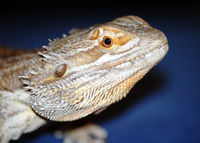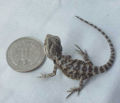| Central Bearded Dragon | ||||||||||||||||
|---|---|---|---|---|---|---|---|---|---|---|---|---|---|---|---|---|
 |
||||||||||||||||
| Scientific classification | ||||||||||||||||
|
||||||||||||||||
| Pogona vitticeps Ahl, 1926 |
The Central Bearded Dragon or Inland Bearded Dragon (Pogona vitticeps) is a type of agamid lizard. Of the several species of the Pogona genus, P. vitticeps is the most commonly seen breed in pet stores throughout the world.
Adult central bearded dragons usually grow to be about two feet in length, with the tail accounting for over half of the total body length. Females are typically smaller than the males. Bearded dragons come in a wide variety of colors, including brown, gray, reddish-brown, and even orange. They are capable of undergoing very slight changes in the shade of their color to help regulate temperature. The specialized scales along both sides of the throat, neck, and head form many narrow spines which run down the side of the body to the tail. When feeling threatened a bearded dragon will flatten its body against the ground, puff out its spiny throat, and open its jaws to make itself appear larger. The bearded dragon is so named because of the spiny throat projections appear similar to a human beard. Males typical have a darker "beard" than females, and during mating season and courtship the "beard" will typically darken to near-black. The bearded dragon, like most agamid lizards, has strong legs which enable it to lift its body completely off the ground while it moves. This is done to reduce the heat taken in from the ground, as well as to increase the air-flow over the belly to cool itself further.
The central bearded dragon is native to the semi-arid to and arid woodlands and rocky desert regions of Central Australia. They are skilled climbers, and often spend just as much time perching on tree limbs, fenceposts, and in bushes than they do on the ground. They spend much of the morning and evening sunning themselves on top of an exposed branch or rock. They are diurnal, but like most desert animals they spend the hottest parts of the day hiding in underground burrows or any other cool hiding spot removed from direct sunlight.
Central bearded dragons are omnivorous. They are voracious eaters, feeding on insects and other invertebrates, and are known to sometimes eat small vertebrates, such as mice, as well. They also occasionally eat soft plant matter such as green leaves, fruits and vegetables, and flowers.
Central bearded dragons reach full sexual maturity around two years of age. Breeding typically occurs in the early summer. Females will lay a clutch of eleven to sixteen oblong-shaped eggs in a shallow nest dug in the sand. After being laid the eggs are left unattended. The eggs will hatch approximately three months later.
Gallery

Bearded Dragon feeding
|

Adult Bearded Dragon
|

Size of newborn Bearded Dragon
|

Underside of baby Bearded Dragon
|

Juvenile Bearded Dragon
|

Central Bearded Dragon at the
Henry Doorly Zoo
|